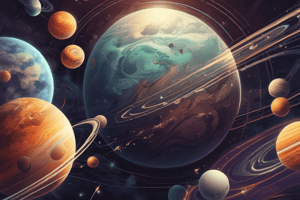Podcast
Questions and Answers
Which of the following is NOT one of the eight recognized planets in the Solar System?
Which of the following is NOT one of the eight recognized planets in the Solar System?
- Mars
- Pluto (correct)
- Neptune
- Venus
The Solar System is comprised of the Sun and four terrestrial inner planets.
The Solar System is comprised of the Sun and four terrestrial inner planets.
False (B)
What defines a celestial body as a planet in the Solar System?
What defines a celestial body as a planet in the Solar System?
A planet must have enough mass to assume a nearly round shape and clear its orbital neighborhood of other debris.
Ceres is classified as a ____ planet and is located in the asteroid belt.
Ceres is classified as a ____ planet and is located in the asteroid belt.
Match each of the following celestial bodies with their classifications:
Match each of the following celestial bodies with their classifications:
Which of the following is a criterion for defining a celestial body as a dwarf planet?
Which of the following is a criterion for defining a celestial body as a dwarf planet?
Pluto was considered the ninth planet of the Solar System from its discovery until 2006.
Pluto was considered the ninth planet of the Solar System from its discovery until 2006.
What is the approximate distance of Pluto from the Sun in astronomical units (AU)?
What is the approximate distance of Pluto from the Sun in astronomical units (AU)?
Natural satellites orbit around _____, not directly around the Sun.
Natural satellites orbit around _____, not directly around the Sun.
Match the following celestial bodies with their classification:
Match the following celestial bodies with their classification:
Flashcards are hidden until you start studying
Study Notes
Solar System Structure
- The Solar System consists of the Sun, 8 planets, 150 confirmed moons, 5 dwarf planets, and billions of small celestial bodies.
- The 8 planets are: Mercury, Venus, Earth, Mars, Jupiter, Saturn, Uranus, and Neptune.
- The 5 dwarf planets are: Ceres, Pluto, Eris, Haumea, and Makemake.
Celestial Bodies Classification
- Celestial bodies orbiting the Sun are classified into three categories: planets, dwarf planets, and small Solar System bodies.
- A planet is a celestial body that has enough mass to assume a hydrostatic equilibrium shape, and has cleared the neighborhood around its orbit.
- A dwarf planet is a celestial body that has enough mass to assume a hydrostatic equilibrium shape, but has not cleared the neighborhood around its orbit.
Pluto's Reclassification
- Pluto was previously considered the 9th planet of the Solar System, but was reclassified as a dwarf planet in 2006 by the International Astronomical Union (IAU).
- The reclassification was due to the discovery of many celestial bodies similar to Pluto, including Eris, which is slightly smaller than Pluto.
Other Solar System Features
- The Kuiper Belt is a region of the Solar System that contains many small celestial bodies, including dwarf planets and asteroids.
- The Oort Cloud is a hypothetical region of the Solar System that contains trillions of small celestial bodies.
- The heliopause is the boundary between the Solar System and interstellar space.
Planetary Distances and Orbits
- The distance of a planet from the Sun varies throughout its orbit, with the closest point called perihelion and the farthest point called aphelion.
- Astronomers use astronomical units (AU) to measure distances within the Solar System, with 1 AU being approximately 149.6 million kilometers.
- Pluto is approximately 38 AU from the Sun, while Jupiter is approximately 5.2 AU away.
Studying That Suits You
Use AI to generate personalized quizzes and flashcards to suit your learning preferences.




